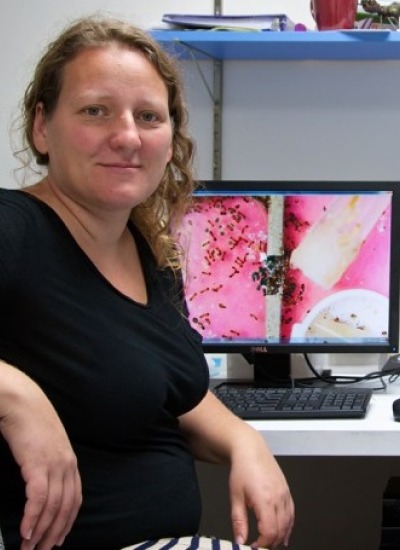Anna R Dornhaus
Publications
Abstract:
When an ant colony needs to find a new nest, scouts are sent out to evaluate the suitability of potential sites, particularly their size. It has been suggested that ant scouts of Leptothorax albipennis use a simple heuristic known as Buffon's needle to evaluate nest size. They do this in two stages: first laying a pheromone trail in the nest site, then, after a return to the old nest, coming back and wandering within the site assessing frequency of intersection with the pheromone trail ("two-pass" strategy). If a colony is forced to relocate from its current nest due to destruction of that nest, the time required to find a suitable new nest may be crucial. This paper details preliminary results from a computer simulation model of evaluation of nest size. The model aims to study why a "two-pass" strategy is used by ants when a "one-pass" strategy, in which the ant simultaneously lays pheromone and assesses the frequency at which it encounters its own trail, may be more time efficient. Analysis of the results indicates no clear advantage for the "two-pass" strategy, given the assumptions of the model. Possible implications of this result are discussed.
featured in PLoS Author SpotlightPMID: 23418475;PMCID: PMC3572167;Abstract:
Floral displays are under selection to both attract pollinators and deter antagonists. Here we show that a common floral trait, a nectar guide pattern, alters the behavior of bees that can act opportunistically as both pollinators and as antagonists. Generally, bees access nectar via the floral limb, transporting pollen through contact with the plant's reproductive structures; however bees sometimes extract nectar from a hole in the side of the flower that they or other floral visitors create. This behavior is called "nectar robbing" because bees may acquire the nectar without transporting pollen. We asked whether the presence of a symmetric floral nectar guide pattern on artificial flowers affected bumble bees' (Bombus impatiens) propensity to rob or access nectar "legitimately." We discovered that nectar guides made legitimate visits more efficient for bees than robbing, and increased the relative frequency of legitimate visits, compared to flowers lacking nectar guides. This study is the first to show that beyond speeding nectar discovery, a nectar guide pattern can influence bees' flower handling in a way that could benefit the plant. © 2013 Leonard et al.
PMID: 16849234;PMCID: PMC1578745;Abstract:
Many natural and artificial decision-making systems face decision problems where there is an inherent compromise between two or more objectives. One such common compromise is between the speed and accuracy of a decision. The ability to exploit the characteristics of a decision problem in order to vary between the extremes of making maximally rapid, or maximally accurate decisions, is a useful property of such systems. Colonies of the ant Temnothorax albipennis (formerly Leptothorax albipennis) are a paradigmatic decentralized decision-making system, and have been shown flexibly to compromise accuracy for speed when making decisions during house-hunting. During emigration, a colony must typically evaluate and choose between several possible alternative new nest sites of differing quality. In this paper, we examine this speed-accuracy trade-off through modelling, and conclude that noise and time-cost of assessing alternative choices are likely to be significant for T. albipennis. Noise and cost of such assessments are likely to mean that T. albipennis' decision-making mechanism is Pareto-optimal in one crucial regard; increasing the willingness of individuals to change their decisions cannot improve collective accuracy overall without impairing speed. We propose that a decentralized control algorithm based on this emigration behaviour may be derived for applications in engineering domains and specify the characteristics of the problems to which it should be suited, based on our new results. © 2005 The Royal Society.
Abstract:
Within-group conflict may influence the degree to which individuals within a group cooperate. For example, the most dominant individuals within a group often gain access to the best resources and may be less inclined to perform risky tasks. We monitored space use and division of labor among all workers in three colonies of bumblebees, Bombus impatiens, during the ergonomic and queenless phases of their colony cycle. We then measured the two largest oocytes in each worker to estimate each individual's reproductive potential at the end of the colony cycle. We show that workers that remained farther from the queen while inside the nest and avoided risky or more energy-expensive tasks during the ergonomic phase developed larger oocytes by the end of the colony cycle. These individuals also tended to be the largest, oldest workers. After the queen died, these workers were more likely than their nestmates to increase brood incubation. Our results suggest that inactive bumblebees may be storing fat reserves to later develop reproductive organs and that the spatial organization of workers inside the nest, particularly the distance workers maintain from the queen, may predict which individuals will later have the greatest reproductive potential in the colony. © 2011 Springer-Verlag.
Pagination
- First page
- …
- 9
- 10
- 11
- …
- Last page


